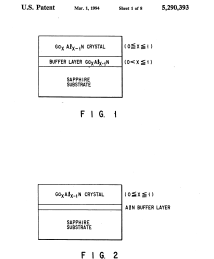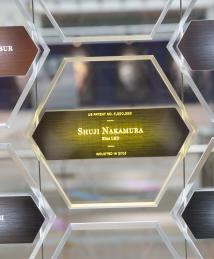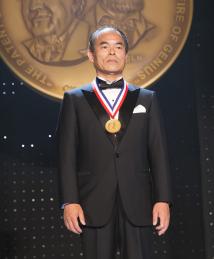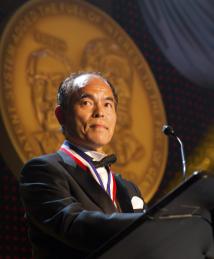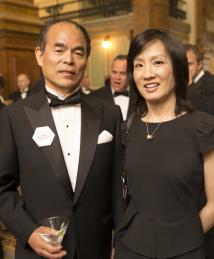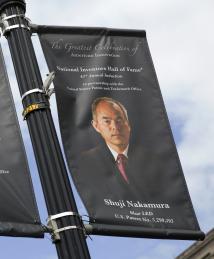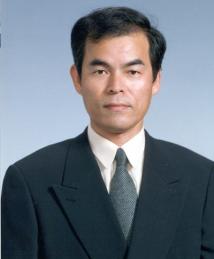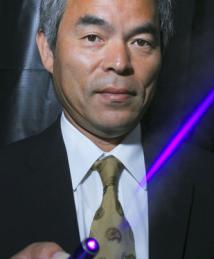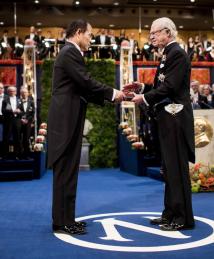Shuji Nakamura
"I was very curious about nature because nature is so beautiful in Oku (Japan). Asking questions about nature is how I became interested in science.”"
Shuji Nakamura invented the blue light-emitting diode (LED), as well as green and white LEDs and the blue laser diode. His groundbreaking inventions have many applications in fields including communication, energy, environmental science, healthcare and life sciences.
Born in Ikata, Japan, in 1954, Nakamura grew up exploring the natural world. “I was very curious about nature because nature is so beautiful in Oku (Japan),” he shared in an interview with the National Inventors Hall of Fame®. “Asking questions about nature is how I became interested in science.” He also was introduced to engineering at a young age by his father, a maintenance worker for Shikoku Electric Power. From him, Nakamura learned how to build wooden toys like catapults and bamboo propellers.
Though he initially intended to become a theoretical physicist or a mathematician, Nakamura was advised by a high school teacher to major in engineering, which would lead to vast job opportunities. When he enrolled at the University of Tokushima in 1972, he chose to study electrical engineering because it seemed close to physics, but it wasn’t until he attended a lecture on semiconductors that he became fully engaged with the subject. He earned his bachelor’s degree in 1977.
While working toward his master’s degree, Nakamura focused his thesis on the conductivity mechanism of barium titanium oxide. His professor, Osamu Tada, encouraged him to conduct manual experiments, giving him the opportunity to build skills like soldering, cutting and joining glass, beating and welding sheet metal, and fashioning parts on a lathe – skills he would later apply to develop the blue LED.
After earning his master’s degree in electrical engineering in 1979, Nakamura joined the research and development division of Nichia Corp., a small company that specialized in phosphorus products for coating the inside of TV screens and fluorescent lamps. Here, Nakamura studied gallium metal, a source material of the gallium arsenide and gallium phosphide used to create red and infrared LEDs. When Nakamura proposed the development of blue gallium nitride (GaN) LEDs – the world’s first bright blue LEDs – Nichia’s president granted him the substantial funding needed for his research. Taking an important step toward his goal, Nakamura grew a film of GaN crystal with an unprecedented level of electron mobility. Looking back on this achievement, he said, “It was the most exciting day of my life.”
By the end of 1992, Nakamura had successfully developed blue LEDs using indium GaN (InGaN). By adjusting the amount of indium inside the semiconductor, he created the energy gap necessary to produce an exceptionally bright blue. “My invention is 100 times brighter so [these] blue LEDs can be used in all kinds of applications,” Nakamura said. In 1994, he developed blue and blue-green LEDs that were twice as bright as his original devices. Later, he enabled the creation of white LEDs by placing yellow phosphor in front of a blue LED, and by combining blue LEDs with existing red and green LEDs, Nakamura was able to produce any color of light.
For decades, the bright blue LED had evaded researchers, halting many display technologies. As Nakamura's innovations allowed for the complete spectrum of colors, LEDs became essential components of technologies including flat-panel displays and video billboards. From the blue LEDs used for machine vision, to the brighter green LEDs that make traffic lights more reliable and efficient, to the white LED backlight displays on smartphones, Nakamura made it all possible.
Benefiting the environment as well as the economy, LEDs consume just 5% of the power of an incandescent bulb while producing many more lumens per watt than either incandescent or fluorescent bulbs. Offering such impressive energy efficiency, the use of LEDs in home lighting has grown significantly in recent years. While in 2015, just 4% of U.S. households used LEDs for most or all of their lighting, that number had grown to 47% by 2020.
Nakamura earned his doctorate in electrical engineering from the University of Tokushima in 1994 and soon made another of his most important contributions – his invention of the blue laser. In 1996, Nichia announced a blue laser that operated for 1,000 hours. Providing a five- to 10-fold increase in data storage capacity, the blue laser led to the creation of Blu-ray and other industry standards.
In 1999, Nakamura joined the University of California, Santa Barbara as a professor of materials and electrical and computer engineering, and he established a research program to study new applications of nitride, including blue violet LEDs and zero-energy-loss LEDs.
Nakamura’s impact has been recognized with awards including the Millennium Prize in 2006, a Technical and Engineering Emmy Award in 2011 and the Nobel Prize in Physics in 2014. He holds more than 200 U.S. patents, as well as over 300 Japanese patents, and has published more than 550 papers in the field of engineering.
